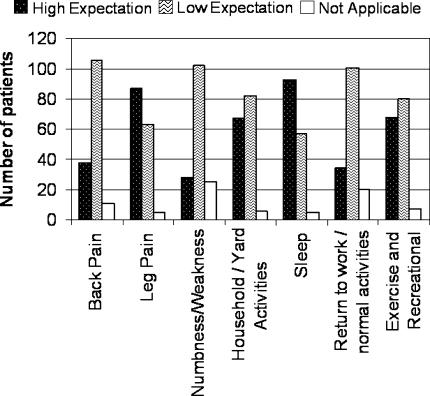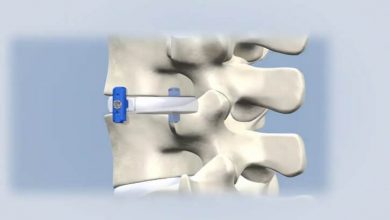Back Surgery – Setting Expectations

A key factor in achieving patient satisfaction for those with back pain is setting expectations for back surgery that are realistic. Numerous studies have found an association between realistic, but positive, expectations for surgical outcome and fulfilment of those positive expectations following surgery for spinal stenosis, degenerative disc disease, and other back complaints. It is important to remember, of course, that fulfilling patient expectations is important but that improvement in symptoms determines the outcome regardless of any prior expectations for back surgery’s benefits. Differences in age, education, working status, and even gender all appear to have an influence on post-surgical patient fulfillment and surgeons are being encouraged to consider these factors when guiding patients in terms of expectations for back surgery’s benefits.

Good Results from Back Surgery when Patients have Higher Expectations
Having overly optimistic expectations can lead to disappointment after back surgery, but it is interesting to note that those with higher baseline expectations are actually more likely to have positive results in contrast to those expecting little from surgery. It may be that those with an expectation of significant benefit are more highly motivated to achieve success and engage in healthier pre- and post-surgical behaviors. A patient with chronic back pain, for example, who expects little from their back surgery is, perhaps, less likely to quit smoking due to a general sense of despair over their health. Back surgery is then less likely to be successful due to an increased risk of psuedoarthrosis (non-union following spinal fusion), impaired healing, and continued spinal degeneration.


The importance of setting realistic expectations for back surgery is not just focused on the patient however, as the surgeon plays a role in guiding the patient to set goals for post-surgical outcome. Unfortunately, in many cases a surgeon may encourage back surgery simply because it is her/his profession and passion, selectively, but subconsciously, disregarding unfavorable evidence and presenting a more positive picture for the patient than is warranted. The use of average success rates, average rate of patient satisfaction, and pain reduction scores can help identify the back surgery procedure, if any, that has the highest likelihood of benefiting the individual patient. However, claiming that “85% of patients are pain-free following discectomy” clearly sets high expectations for back surgery that are unlikely to be met by all patients.
Elderly Patients Have Higher Satisfaction after Back Surgery
Gepstein (et al, 2006) found that elderly patients’ surgical outcomes could be predicted fairly well by examining their pre-surgical expectations. It is possible that this higher incidence of fulfillment in elderly patients comes from the patients looking at improved function, rather than pain relief, as the determinant of success following back surgery. Where patients expect significant pain relief following back surgery it appears that they are more likely to be disappointed, whereas those anticipating an improved ability to engage in ordinary everyday activities are often happier with the results of their procedure (Iversen, et al, 1998). The intangible nature of back pain is a likely contributing factor here as functional outcomes can be more easily measured, with steady improvement providing further encouragement for patients in terms of engagement with physical therapy and healthy post-surgical behaviours. A slight reduction in back pain is less likely to help patients feel positive about surgical success and, therefore, less likely to encourage further improvements.


There are also other inter-individual differences to contend with when it comes to setting expectations for back surgery. Patients who are not only older but also male and better educated are more likely to have positive expectations of back surgery and, moreover, these positive expectations are associated with a better surgical outcome (Gepstein, et al, 2006). The reasons for such positivity, and the fulfilment of anticipated results, may be due to factors including better social support networks, expectation of recovery by family members and colleagues, better self-esteem and, accordingly, improved motivation towards personal care, as well as myriad other issues.
Back Surgery Success Seen Differently by Patients and Doctors
Additionally, the level of satisfaction following back surgery in patients who receive workers’ compensation compared to those not receiving workers’ compensation tends to be lower. Indeed, one study (Mannion, et al, 2009) found that in a non-workers’ compensation group there was a clinically and statistically significant advantage for back surgery at 3 months that remained significant at 2 years in contrast to the workers’ compensation group where the benefit of surgery diminished with time and was no longer significant at the two-year mark. Other research has observed similar effects, with discectomy cited as having a 95-98% success rate in the eyes of the surgeons, a 74% success rate in terms of patients being free of pain medication and returning to work, and only a 29% success rate for patients on workers’ compensation. The actual clinical signs were not in dispute in such cases, rather it is the expectations set prior to surgery and the factors included in the assessment of success that differ here.

Many back surgeons will consider a single-level fusion procedure to have a 98% success rate as this is the average incidence of actual fusion that occurs. In stark contrast, patients undergoing this procedure report a reduction in back pain in just 40-80% of cases. The gap in these statistics is partly due to inappropriate back surgery, complications from the surgery itself, alternative causes of pain not addressed by the surgery, and other causes of failed back surgery syndrome. Patients need to carefully consider their options when it comes to back surgery and are usually only encouraged to undergo surgical treatment once day to day living becomes intolerable due to leg and/or back pain. Back surgery can exacerbate an existing condition that could be managed through alternative conventional treatment strategies that are yet to be explored by the patient or physician.
Do Surgeons Encourage Realistic Expectations for Back Surgery Success?
Whilst surgeons are not all simply pushing spinal surgery on their patients in order to make more money, it is important to consider that back surgery is their specialty and they will often favor the outcome from surgery over many other treatments due to their immersion in the research and practice of back surgery. Asking about a surgeon’s success rate and the experiences of previous, similar, patients is advisable prior to scheduling back surgery but bearing in mind that all patients are different, and average outcomes are not always predictive of success following back surgery is important so as to avoid disappointment as well as low expectations. Patients should never feel pressured into having back surgery and where a patient is comfortable and hopeful over the success of such treatment the outcome is more likely to be favorable.

It seems that a healthy balance between having a positive goal in mind following back surgery and, at the same time, appreciating that success is by no means guaranteed is the coveted ‘middle-way’ for surgeons and patients alike. There are risks associated with back surgery that require careful consideration and a healthy collaboration between a patient and their surgeon can ensure that the patient has adequate personal resources and outside help to meet the challenges of any back surgery in terms of both physical and mental demands. Increasingly, emphasis is being placed on the importance of patients’ expectations prior to back surgery and their association with a positive outcome and physicians and surgeons are being encouraged to develop a healthy and realistic attitude towards surgical goals for both themselves and their patients. For patients with any spine condition, be it spinal stenosis, arthritis, acute spinal injury, scoliosis, or other issue, setting expectations for back surgery that are positive, but realistic, is a major factor in achieving a good outcome for all.





